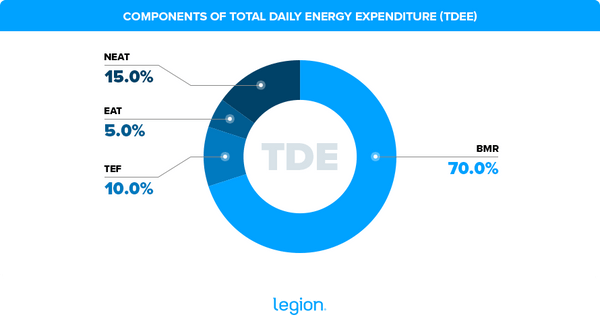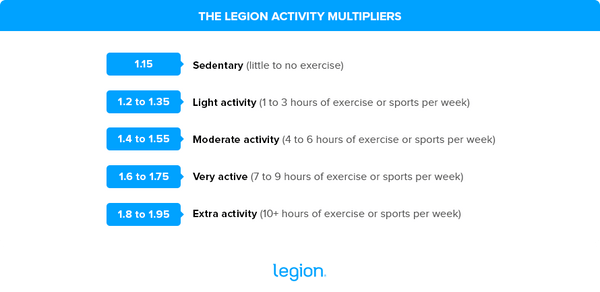Use the Legion TDEE Calculator to calculate your total daily energy expenditure (TDEE)—an estimate of how many calories you burn each day based on your body weight, height, age, and activity level.
What Is TDEE?
TDEE, or total daily energy expenditure, is the total amount of energy you expend every 24 hours, expressed in calories.
There are four main components of TDEE:

- Basal metabolic rate (BMR): BMR is the number of calories your body burns performing basic vital functions, such as breathing, pumping blood around your body, and maintaining brain function. It accounts for around 70% of TDEE.
- Thermic effect of food (TEF): TEF is the number of calories you burn digesting food. On average, TEF accounts for around 10% of your TDEE, though this can vary depending on the types of food you eat. For instance, protein has a TEF of ~20-to-30%, carbs have a TEF of ~5-to-10%, and fat has a TEF of ~0-to-3%.
- Exercise activity thermogenesis (EAT): EAT is the number of calories you burn doing formal exercise. For most people, EAT contributes approximately 5% to TDEE.
- Non-exercise activity thermogenesis (NEAT): NEAT is the number of calories you burn from any physical activity that isn’t formal exercise (the calories you burn going about daily activities, basically). It accounts for around 15% of TDEE for most people.
People primarily use the information provided by a TDEE calculator to lose weight, gain muscle, or maintain their physique.
They do this by manipulating their calorie intake based on the following three premises:
- Eating more than your TDEE causes weight gain: If you consistently eat more than your TDEE, you’ll gain weight both in the form of body fat and lean body mass (primarily muscle). To gain muscle while accumulating as little fat as possible, aim to eat 5-to-10% above your TDEE.
- Eating less than your TDEE drives fat loss: You’ll lose weight if you consistently eat fewer calories than your TDEE. Provided you eat adequate protein and lift weights, most of the weight you lose will be fat. To lose fat quickly and healthily, eat 20-to-25% fewer calories than your TDEE.
- Matching your caloric intake to your TDEE aids weight maintenance: Aligning your daily calorie intake with your energy expenditure allows you to maintain your weight. Maintaining your weight is a good option for those who have reached their goal physique and no longer want to bulk or cut.
How to Calculate TDEE
The easiest way to calculate your TDEE is to use the total daily energy expenditure calculator above.
However, if you want to crunch the number yourself, start by calculating your BMR.
There are several equations for this, but I suggest the Mifflin-St Jeor equation:
For men: BMR = 10 x weight (kg) + 6.25 x height (cm) – 5 x age (years) + 5
For women: BMR = 10 x weight (kg) + 6.25 x height (cm) – 5 age (years) – 161
I favor the Mifflin-St Jeor equation over other formulas, like the Harris-Benedict or Katch-McArdle equations, as it generates accurate results without requiring much math or your body fat percentage.
The next step is accounting for the additional energy expenditure by applying activity multipliers. To do this, multiply your BMR by the multiplier below that best describes your activity level:
- Sedentary: 1.2
- Lightly Active: 1.375
- Moderately Active: 1.550
- Very Active: 1.725
- Extra Active: 1.9
These multipliers feature in most TDEE calculators and have undoubtedly helped many people with maintaining, gaining, and losing weight. However, based on my experience assisting tens of thousands of people, these multipliers often overestimate your energy expenditure.
In other words, if you use the above multipliers, you’ll probably place yourself in too small of a calorie deficit when cutting (resulting in less-than-optimal fat loss) and too large of a surplus when bulking (resulting in more-than-optimal fat gain).
Therefore, I recommend using lower activity multipliers.
Here’s how I do it:

Those multipliers should give you a more accurate starting point, and they’re what we built into the Legion TDEE Calculator.
FAQ #1: What is the best TDEE calculator?
If you don’t know your body fat percentage, TDEE calculators that use the Mifflin-St Jeor equation are best. This equation tends to produce the most accurate TDEE calculator results.
If you know your body fat percentage, using a calorie expenditure calculator that utilizes the Katch-McArdle equation is the most accurate.
TDEE calculators that use the Harris-Benedict equation aren’t as accurate as those that use the Mifflin-St Jeor and Katch-McArdle equations, but we provided it in our TDEE calculator because it’s a well-known and popular formula.
FAQ #2: Should I eat my TDEE to lose weight?
No. Your TDEE is how many calories you need to maintain your weight. Thus, if you want to lose weight, you need to eat fewer calories than your TDEE.
To learn more about this, check out this article:
The Complete Guide to Safely and Healthily Losing Weight Fast
FAQ #3: How do you use your TDEE to lose weight?
To lose weight, you’ll need to eat fewer calories than your TDEE. Research shows a good calorie target for weight loss is 75% of your TDEE (25% below your TDEE). For most people, this comes out to 10-to-12 calories per pound of body weight per day.
This is enough to lose weight quickly (about 1-to-2 pounds per week) without causing excessive hunger or cravings or disrupting your performance in the gym.
To learn more about how to use your TDEE to lose weight, use the TDEE calculator above.
FAQ #4: Is TDEE the same as BMR for weight loss?
No, TDEE (total daily energy expenditure) and BMR (basal metabolic rate) are not the same, although they are related.
BMR is the number of calories your body needs to perform basic life-sustaining functions like breathing and circulation at rest. TDEE, on the other hand, includes BMR plus the calories burned through physical activity and the digestion of food.
For weight loss, TDEE is a more useful measure as it accounts for your overall daily activities, not just the energy spent at rest.
FAQ #5: Do you lose weight by eating at TDEE?
Eating at your TDEE means consuming the number of calories your body uses in a day. If you eat at your TDEE, you will maintain your current weight. To lose weight, you need to create a calorie deficit, which means consuming fewer calories than your TDEE.
For healthy, sustainable weight loss, aim to eat 20-to-25% below your TDEE. And to get precise information about how many calories that means for you, use the calorie expenditure calculator above.
FAQ #6: Can I increase my daily TDEE?
Yes, you can increase your daily TDEE. Increasing your level of physical activity is the most effective way to raise your TDEE. This can include both structured exercise (like strength training or cardio) and non-exercise activities (like walking more or using the stairs instead of an elevator or escalator).
Additionally, building muscle through strength training can raise your BMR, which in turn increases your TDEE. Eating a high-protein diet can also slightly boost the thermic effect of food, contributing to a higher TDEE.
+ Scientific References
- Maciak, Sebastian, et al. “Low Basal Metabolic Rate as a Risk Factor for Development of Insulin Resistance and Type 2 Diabetes.” BMJ Open Diabetes Research & Care, vol. 8, no. 1, July 2020, p. e001381, drc.bmj.com/content/bmjdrc/8/1/e001381.full.pdf, https://doi.org/10.1136/bmjdrc-2020-001381. Accessed 19 Feb. 2021.
- Ravn, Anne-Marie, et al. “Thermic Effect of a Meal and Appetite in Adults: An Individual Participant Data Meta-Analysis of Meal-Test Trials.” Food & Nutrition Research, vol. 57, no. PMC3873760, 23 Dec. 2013, www.ncbi.nlm.nih.gov/pmc/articles/PMC3873760/#CIT0009, https://doi.org/10.3402/fnr.v57i0.19676.
- Tappy, L. “Thermic Effect of Food and Sympathetic Nervous System Activity in Humans.” Reproduction Nutrition Development, vol. 36, no. 4, 1996, pp. 391–397, https://doi.org/10.1051/rnd:19960405. Accessed 28 Mar. 2020.
- Amirkalali, Bahareh, et al. “Comparison of Harris Benedict and Mifflin-ST Jeor Equations with Indirect Calorimetry in Evaluating Resting Energy Expenditure.” Indian Journal of Medical Sciences, vol. 62, no. 7, 1 July 2008, pp. 283–290, pubmed.ncbi.nlm.nih.gov/18688113/.
- Huovinen, Heikki T., et al. “Body Composition and Power Performance Improved after Weight Reduction in Male Athletes without Hampering Hormonal Balance.” Journal of Strength and Conditioning Research, vol. 29, no. 1, Jan. 2015, pp. 29–36, https://doi.org/10.1519/jsc.0000000000000619.











